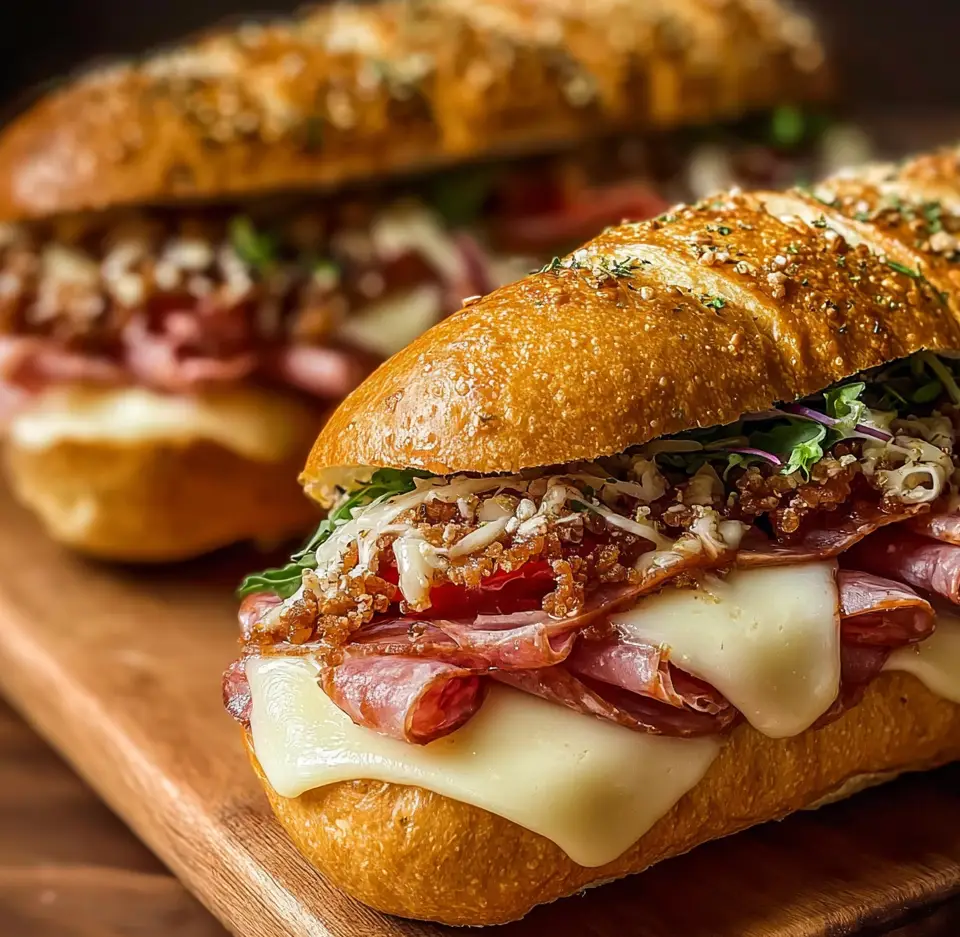Prep Time: 15 minutes Cook Time: 20 minutes Total Time: 35 minutes Serves: 6
Discover the magic of these spectacular baked Italian sub sandwiches that transform ordinary deli ingredients into extraordinary hot sandwiches because they feature layers of premium meats, melted cheese, and tangy peppers all nestled in toasted hoagie rolls. These irresistible baked Italian sub sandwiches deliver everything you crave in a perfect sandwich because they combine the classic flavors of traditional cold subs with the added bonus of melted cheese, crispy bread, and warm, savory meat that creates an unforgettable eating experience guaranteed to become your new favorite meal.
Why Baked Italian Sub Sandwiches Win Every Time
These magnificent baked Italian sub sandwiches succeed brilliantly because they elevate the humble submarine sandwich from quick lunch to special occasion worthy meal through the simple act of baking. The heat transforms the ingredients because melting cheese binds everything together, toasting bread creates textural contrast, and warming meats releases aromatic oils that fill your kitchen with irresistible Italian deli shop fragrance.
The genius of these baked Italian sub sandwiches lies in their incredible versatility because they work equally well for casual weeknight dinners, game day gatherings, or feeding crowds at parties and potlucks. The combination of multiple Italian meats creates complexity because each variety contributes unique flavor and texture, from spicy pepperoni to delicate capicola to robust salami that work together harmoniously.
These beloved baked Italian sub sandwiches appeal to everyone because they satisfy hearty appetites while offering familiar, comfort food flavors presented in exciting format. The recipe demonstrates how simple techniques like proper layering and strategic baking transform ordinary ingredients because attention to detail and quality components create restaurant-quality results at home.
Essential Ingredients for Perfect Baked Italian Sub Sandwiches
For the Bread:
- 6 hoagie rolls or sub rolls, about 6 inches each
- 1/2 cup Italian dressing, divided
- 2 tablespoons butter, melted
For the Meat Layers:
- 12 slices deli ham, thinly sliced
- 12 slices Genoa salami
- 12 slices capicola or hot ham
- 12 slices pepperoni
- 8 slices mortadella, optional
For the Cheese:
- 12 slices provolone cheese
- 1 cup shredded mozzarella cheese
For the Vegetables:
- 1 cup sliced banana peppers or pepperoncini
- 1 medium red onion, thinly sliced
- 2 large tomatoes, thinly sliced
- 2 cups shredded iceberg lettuce
For Seasoning:
- 1 tablespoon Italian seasoning
- 1 teaspoon garlic powder
- 1/2 teaspoon crushed red pepper flakes
- Salt and black pepper to taste
The Art of Creating Baked Italian Sub Sandwiches
Mastering these delectable baked Italian sub sandwiches requires understanding the relationship between bread preparation, meat layering, and cheese placement because success depends on creating structure that holds together while ensuring every component receives proper heat exposure. The bread treatment proves crucial because lightly toasting before filling creates a moisture barrier that prevents sogginess while adding desirable crunch.
The meat layering strategy affects final results because folding slices rather than laying them flat creates texture and allows better cheese melting between layers. The cheese positioning matters significantly because placing some directly on the bread creates a melted barrier, while top layer cheese provides the attractive golden, bubbly finish that makes these baked Italian sub sandwiches so visually appealing.
Temperature management becomes essential because these sandwiches require heat high enough to melt cheese and crisp bread without drying out the meat or burning the exterior. The brief baking time ensures everything heats through perfectly because extended cooking toughens the meat and makes bread too hard to bite comfortably.
Step-by-Step Instructions for Baked Italian Sub Sandwiches
Step 1: Prepare the Bread
Preheat oven to 350°F and line a large baking sheet with parchment paper because proper preparation prevents sticking and facilitates cleanup. Slice hoagie rolls lengthwise without cutting completely through because maintaining the hinge keeps sandwiches intact and makes filling easier.
Professional Tip: Open the rolls like a book and gently press down to create a slight well in each half because this depression helps hold fillings and prevents ingredients from sliding out.
Key Points: Brush the inside of both halves with Italian dressing because this adds moisture and flavor while creating a protective layer that prevents bread from becoming soggy during baking.
Step 2: Toast the Bread Lightly
Place opened rolls on the baking sheet and bake for 5 minutes because this preliminary toasting creates a slightly crispy surface that holds up better under moist ingredients. Watch carefully to prevent over-browning because you want light toasting, not full crispiness at this stage.
Professional Tip: Remove rolls from oven when they just begin to feel firm because residual heat continues the toasting process even after removal.
Key Points: This pre-baking step distinguishes great baked Italian sub sandwiches from soggy disappointments because the moisture barrier prevents wet ingredients from penetrating the bread.
Step 3: Layer the Meat Foundation
Start with ham slices on the bottom half of each roll because this mild meat provides a base that doesn’t overpower other flavors. Fold each slice in half or thirds rather than laying flat because folding creates texture and allows heat to penetrate between layers.
Professional Tip: Use freshly sliced deli meat when possible because pre-packaged varieties often contain more preservatives and lack the superior texture and flavor of fresh-cut options.
Key Points: Add 2-3 slices of each meat type per sandwich because generous portions create satisfying sandwiches, but too much meat makes them difficult to eat.
Step 4: Build the Meat Layers
Continue layering with salami, then capicola, followed by pepperoni because this order progresses from mild to spicy, creating flavor complexity. Add mortadella if using because this delicate bologna-style meat adds subtle flavor and soft texture that complements the firmer meats.
Professional Tip: Alternate folding directions for each meat layer because varying the folds creates more interesting texture and helps the sandwich hold its shape better.
Key Points: Keep meat layers within the bread boundaries because overhang leads to burnt edges and makes the sandwiches messy to eat.
Step 5: Add Cheese Strategically
Place provolone slices directly over the meat layers because this creates the first melted cheese barrier. Break each slice in half if needed to achieve better coverage because complete cheese distribution ensures every bite contains melted goodness.
Professional Tip: Sprinkle shredded mozzarella over the provolone because combining cheese types creates more complex flavor and superior melting characteristics.
Key Points: Reserve some cheese for the top because dual cheese layers create the attractive golden surface that makes these baked Italian sub sandwiches Instagram-worthy.
Step 6: Layer the Vegetables
Arrange banana peppers or pepperoncini over the cheese because these tangy, slightly spicy peppers add essential brightness that cuts through rich meats and cheese. Add thinly sliced red onion because this provides sharp, aromatic notes and textural crunch.
Professional Tip: Pat peppers dry with paper towels before adding because excess liquid creates steam that can make bread soggy during baking.
Key Points: Save tomatoes and lettuce for after baking because heat makes tomatoes watery and lettuce wilted, compromising texture and appearance.
Step 7: Season and Prepare for Baking
Sprinkle Italian seasoning, garlic powder, and crushed red pepper flakes over the vegetables because these dried herbs and spices bloom in the oven heat, releasing aromatic oils. Add salt and black pepper to taste because proper seasoning enhances all other flavors.
Professional Tip: Go light on salt because the meats, cheese, and peppers already contain significant sodium, and over-salting creates unpleasantly salty sandwiches.
Key Points: Brush the top half of each roll with remaining Italian dressing because this adds flavor and helps the bread toast evenly without drying out.
Step 8: Final Assembly and Baking
Close the sandwiches gently but firmly because you want everything compressed slightly without squashing the bread completely. Place sandwiches in the oven and bake for 15-20 minutes because this timing melts cheese perfectly while crisping bread without over-cooking meat.
Professional Tip: Check sandwiches at 15 minutes because oven temperatures vary, and you want golden, melted cheese without burnt bread edges.
Key Points: The sandwiches are ready when cheese is fully melted and bubbly and bread edges are golden brown because these visual cues indicate perfect doneness.
Step 9: Add Fresh Elements
Remove sandwiches from oven and let rest for 3-4 minutes because brief cooling allows cheese to set slightly, making sandwiches easier to handle. Open each sandwich carefully and add tomato slices and shredded lettuce because fresh, cool vegetables provide textural contrast and flavor balance.
Professional Tip: Drizzle additional Italian dressing over the fresh vegetables because extra moisture and flavor at this stage refreshes the hot components.
Key Points: Add fresh elements immediately before serving because prolonged contact with hot sandwich makes them wilt and lose their appealing texture.
Step 10: Slice and Serve
Cut each sandwich in half at an angle using a sharp, serrated knife because diagonal cuts create attractive presentation and make sandwiches easier to handle. Serve immediately while hot because these baked Italian sub sandwiches taste best when cheese is still melted and bread is warm and crispy.
Professional Tip: Wipe the knife clean between cuts because this creates cleaner slices that showcase the beautiful layers.
Key Points: Offer extra Italian dressing, mayo, or mustard on the side because condiment preferences vary, and allowing customization ensures everyone enjoys their sandwich exactly how they like it.
Professional Tips for Perfect Baked Italian Sub Sandwiches
Choose quality hoagie rolls from a bakery when possible because fresh-baked bread with proper crust-to-crumb ratio makes significant difference in final results. Visit the deli counter for freshly sliced meats because pre-packaged options lack the superior texture, flavor, and flexibility of freshly cut varieties.
Use full-fat cheese rather than reduced-fat versions because proper melting characteristics depend on adequate fat content, and low-fat cheeses often become rubbery or fail to melt properly. Bring ingredients to room temperature before assembly because cold components require longer baking time and can result in over-toasted bread or under-melted cheese.
Make these baked Italian sub sandwiches ahead by preparing them completely without baking because assembled sandwiches refrigerate well for up to 24 hours wrapped tightly, then bake when ready. Double or triple the recipe easily because these sandwiches feed crowds efficiently and disappear quickly at gatherings.
Creative Variations for Baked Italian Sub Sandwiches
Transform these classic baked Italian sub sandwiches into exciting alternatives because customization accommodates different tastes and dietary preferences. Try substituting roast beef or turkey for traditional Italian meats because these options create different flavor profiles while maintaining the essential sandwich structure.
Add sautéed bell peppers and mushrooms because cooked vegetables provide earthy sweetness that complements the salty meats beautifully. Experiment with different cheese combinations like sharp cheddar, fontina, or pepper jack because cheese selection dramatically affects flavor intensity and heat level.
Create vegetarian versions using grilled vegetables, fresh mozzarella, and pesto because these substitutions maintain satisfying texture while eliminating meat. For extra indulgence, spread garlic butter on bread before baking because this creates aromatic, crispy edges that take these baked Italian sub sandwiches to another level.
Perfect Pairing Ideas for Baked Italian Sub Sandwiches
These hearty baked Italian sub sandwiches pair beautifully with lighter sides because balance creates more enjoyable meals. Serve alongside crisp, refreshing salad options because fresh greens with tangy vinaigrette provide cooling contrast to rich, warm sandwiches.
Consider offering elegant snacks and appetizers before serving because lighter starters prepare appetites without overwhelming. Round out the meal with carefully selected perfect side dishes because options like pasta salad, coleslaw, or chips add variety and complete the dining experience.
Pair with cold beer, iced tea, or Italian sodas because refreshing beverages cleanse the palate between bites and complement the bold Italian flavors perfectly. Include pickle spears or marinated vegetables because these acidic accompaniments cut through richness and add textural variety.
Discover More Sandwich Sensations
Expand your sandwich-making repertoire with complementary recipes because versatility keeps lunch and dinner interesting. Explore creative savory side preparations because robust accompaniments create complete meals that satisfy various appetites and preferences.
Enhance your meals with flavorful dips and marinades because versatile sauces add excitement to simple sandwiches and vegetables alike. Include refreshing beverage selections because well-chosen drinks balance rich foods and enhance overall dining experiences.
Consider morning meal breakfast favorites because sandwich techniques translate beautifully to breakfast dishes that feed crowds efficiently and deliciously.
Storage Guidelines for Baked Italian Sub Sandwiches
Proper storage techniques preserve both flavor and texture because these baked Italian sub sandwiches can provide delicious meals for days when handled correctly. Cool completely before wrapping because hot sandwiches create condensation that makes bread soggy and promotes bacterial growth.
Wrap individual sandwiches tightly in aluminum foil or plastic wrap for up to 3 days because proper sealing prevents drying and maintains freshness. Reheat in a 350°F oven for 10-12 minutes because gentle warming restores crispiness and melts cheese without toughening meat.
Avoid freezing assembled sandwiches because bread texture suffers significantly upon thawing, though you can freeze just the meat and cheese components. Prepare sandwiches fresh when possible because optimal texture and flavor occur when components are newly combined and baked.
The Science Behind Perfect Baked Italian Sub Sandwiches
Understanding bread chemistry improves results because knowledge of crust formation, moisture migration, and starch behavior helps optimize baking techniques. Pre-toasting creates a moisture barrier because heat causes surface starches to gelatinize and form a crust that resists liquid penetration.
Cheese melting involves protein denaturation and fat liquefaction because heat breaks down casein structures while releasing butterfat that creates glossy, stretchy texture. The layering strategy promotes even heat distribution because alternating dense and porous ingredients allows hot air circulation throughout the sandwich.
Meat warming releases aromatic compounds because heat volatilizes fat-soluble flavor molecules, creating the enticing aroma that makes these baked Italian sub sandwiches so appealing even before eating.
Troubleshooting Common Baked Italian Sub Sandwiches Issues
Soggy bread results from excess moisture or insufficient pre-toasting because wet ingredients penetrate soft bread easily. Drain all peppers thoroughly and pre-toast bread longer because these precautions create better barriers against moisture.
Burnt edges occur when oven temperature is too high or baking time is too long because excessive heat causes rapid browning before interior components warm properly. Lower temperature to 325°F and cover loosely with foil because these adjustments promote even heating without burning.
Unmelted cheese happens when sandwiches are too cold or baking time is too short because proper melting requires adequate heat exposure. Bring assembled sandwiches to room temperature before baking because starting with warmer ingredients reduces cooking time and improves results.
Additional Italian-Inspired Recipe Ideas
Continue exploring Italian flavors because mastering traditional techniques enables creation of numerous authentic dishes. Consider sweet endings with delightful dessert recipes because Italian sweets like tiramisu or panna cotta provide perfect conclusions to sandwich meals.
Build confidence with similar hot sandwich preparations because the principles learned here translate to panini, stromboli, and calzones. Remember that Italian cooking celebrates quality ingredients and simple preparations because these characteristics allow individual flavors to shine rather than being masked by complicated techniques.
Conclusion
These magnificent baked Italian sub sandwiches represent the perfect marriage of convenience and quality because they transform simple deli ingredients into extraordinary meals through strategic assembly and brief baking. The combination of multiple meats, melted cheese, and toasted bread creates sensory delight because visual appeal, aromatic fragrance, and complex flavors work together to deliver complete satisfaction.
Whether preparing quick weeknight dinners, game day spreads, or casual entertaining menus, these baked Italian sub sandwiches guarantee success because the straightforward technique produces consistently delicious results that impress without requiring advanced culinary skills. The recipe’s flexibility encourages creativity because meat selections, cheese choices, and vegetable additions allow personalization while maintaining the essential characteristics that make Italian subs comforting, satisfying, and absolutely unforgettable.









